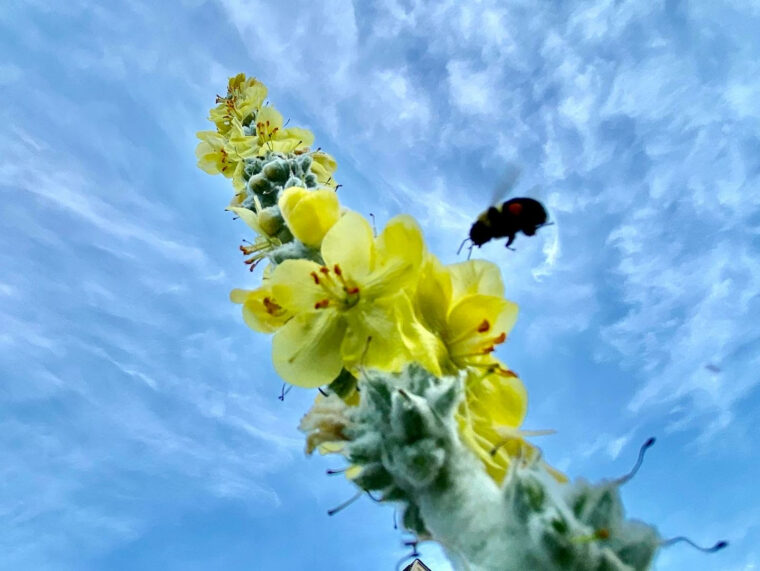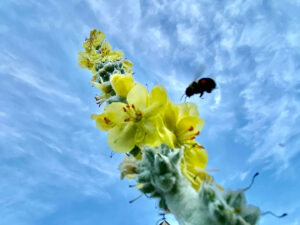
Felix Carroll Photo
The best diet for pollinators
By Thomas Christopher
Concern began with the precipitous decline of honeybee populations in the early 2000s. Suddenly, farmers and orchardists were struggling to find sufficient numbers of bees to pollinate their crops. This, in turn, brought attention to the more general and critical decline among populations of native pollinating insects such as bumble bees, wasps, beetles, and flies.
In one of their finest moments, American gardeners began to pitch in, planting pollinator gardens and pollinator pathways to create new and more hospitable habitat for the pollinators. The crisis is hardly over; indeed, the response is nowhere near equal yet to the threat. Gardeners’ attitudes toward insects, however, have dramatically changed. Once viewed merely as pests to be exterminated, insects are now understood by most gardeners as essential elements of the garden ecosystem. This fundamental transformation in attitudes will, I believe, help to change many other aspects of our relationship to the natural landscape.
The emphasis given to fostering pollinators has, however, also exacerbated a conflict already rife among gardeners. Fans of native plants began to assert that their plants, which co-evolved with the native pollinators, provide them with superior nutrition, nectar and pollen better attuned to the pollinators’ dietary needs. And so, the argument goes, native plants are more beneficial to native pollinators. Horticultural traditionalists, who are commonly absorbed in creating landscape designs with the long-beloved garden flowers collected from all around the world, found themselves on the defensive. They began to point out that many of their non-native plants attracted many pollinators. Articles and blog posts began to appear insisting that our exotics are just as good in this respect as your natives.
For an informed insight into this disagreement, I contacted Dr. Harland Patch of Pennsylvania State University, an entomologist whose research interests include pollinator health and planting to promote pollinator diversity. A few years ago I had heard him give a very interesting talk about bee nutrition and the differing value of various flowers’ pollen and nectar.
When I spoke to him, I found him disinclined to endorse either faction’s dogma. He noted that some types of native pollinators are “specialists” who have evolved into a dependency on certain species of native plants. These pollinators cannot flourish in the absence of their plant partners, and often the plants depend on the services of those particular pollinators. However, such exclusive relationships are uncommon, Dr. Patch added, for an obvious reason: they make both the plants and pollinators very vulnerable to any sort of natural event that affects the partner.
More common are “generalist” pollinators who feed on a variety of plant pollens and nectars. Indeed, the generalists do not thrive, typically, if confined to one plant species’ products. Generalists will commonly take advantage of exotic as well as native flowers. One problem that many of our traditional garden plants do have, Dr. Patch added, is that they have been bred for horticultural qualities such as bloom size and color or double flowers, and may not benefit insects as much as did their wild ancestors.
Of course, native plants provide other benefits to native pollinators. Most types of our moths and butterflies, for example, depend on certain types of native plants as food for their larval forms. Dr. Patch endorsed planting mostly natives, but saw no reason to exclude favorite exotics. If, he added, you are focusing strictly on pollinator nutrition, diversity of planting, so that you provide many different types of flowers and different pollens and nectars throughout the growing season, is most important to maintaining pollinator diversity and health. Flies, for example, an important if commonly overlooked class of pollinators, are particularly attracted to members of the carrot family.
When I asked Dr. Harland for sources of information about plants that are particularly important to different classes of native pollinators, he invited me to visit Penn State’s new 3-acre Pollinator and Bird Garden. Located in the university’s arboretum, this garden, which was completed in July of 2021, includes a variety of habitats, ranging from a pond and wetlands to forest and dry meadow, and 390 species and varieties of plants, most of them native to central Pennsylvania. As well as a demonstration of what gardeners can achieve in their own landscapes, this garden is also a laboratory for university scientists and Penn State’s multidisciplinary Center for Pollinator Research.
To hear more of Dr. Patch’s advice to pollinator-friendly gardeners, listen to a recording of our conversation on the Berkshire Botanical Garden’s “Growing Greener” podcast at berkshirebotanical.org.
Be-a-Better-Gardener is a community service of Berkshire Botanical Garden, located in
Stockbridge, Mass. Its mission, to provide knowledge of gardening and the environment through a diverse range of classes and programs, informs and inspires thousands of students and visitors each year. Thomas Christopher is a volunteer at Berkshire Botanical Garden and is the author or co-author of more than a dozen books, including Nature into Art and The Gardens of Wave Hill (Timber Press, 2019). He is the 2021 Garden Club of America's National Medalist for Literature, a distinction reserved to recognize those who have left a profound and lasting impact on issues that are most important to the GCA. Christopher’s companion broadcast to this column, Growing Greener, streams on WESUFM.org, Pacifica Radio and NPR and is available at berkshirebotanical.org/growinggreener.

Thomas Christopher is the co-author of “Garden Revolution” (Timber Press, 2016) and is a volunteer at Berkshire Botanical Garden. berkshirebotanical.org
Be-a-Better-Gardener is a community service of Berkshire Botanical Garden, one of the nation’s oldest botanical gardens in Stockbridge, MA. Its mission to provide knowledge of gardening and the environment through 25 display gardens and a diverse range of classes informs and inspires thousands of students and visitors on horticultural topics every year. Thomas Christopher is the co-author of Garden Revolution (Timber press, 2016) and is a volunteer at Berkshire Botanical Garden. berkshirebotanical.org.


